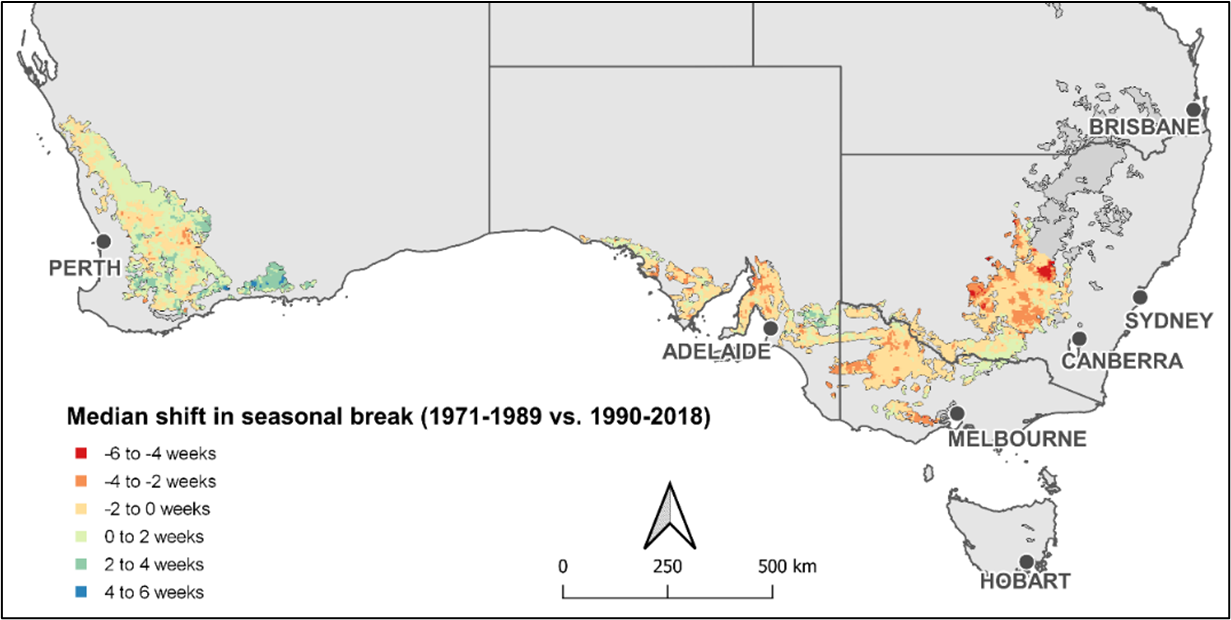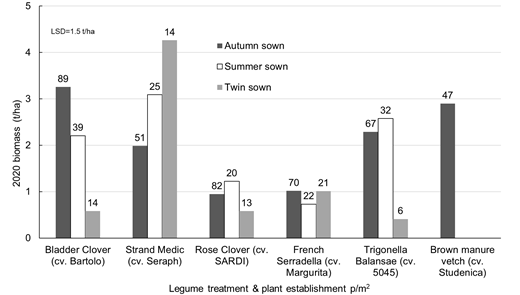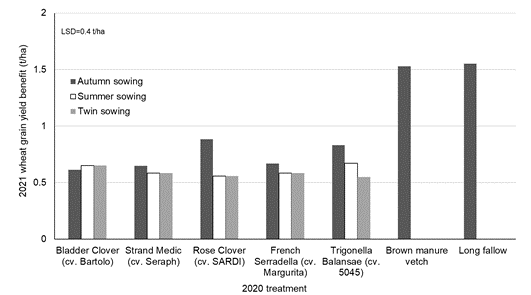Adaptive sowing strategies to overcome a shifting seasonal break
Author: Bonnie Flohr, Therese McBeath, Jackie Ouzman, Bill Davoren, Willie Shoobridge & Greg Rebetzke (CSIRO), Ross Ballard & David Peck (SARDI), Rick Llewellyn, John Kirkegaard and Belinda Stummer (CSIRO) | Date: 08 Feb 2022
Take home messages
- Seasonal changes may be altering the pattern of sowing opportunities across southern Australia, but there is potential to adapt management to deal with these changes.
- Deep-sown wheat cultivars with long coleoptiles may reduce the dependence on the seasonal break to establish crops but soil texture and soil water are important factors for success.
- There are alternative methods to sow legume-pastures that avoid clashes with main crop sowing programs and establish pasture seedbanks.
Background
The seasonal break is a rainfall event that has traditionally initiated sowing and enabled plant establishment in southern cropping environments of Australia. Delays in the seasonal break reduce grain yield (~1—7% yield loss per week delay past optimal establishment time for wheat) and for graziers can result in continued summer-autumn feed gaps requiring supplementary feeding and reduced grazing during the winter period when cool temperatures slow pasture growth (Coventry et al. 1993; Pook et al. 2009; Hochman and Horan, 2018). Despite its importance to agricultural production, neither the pattern of the seasonal break, nor the impact of recent autumn rainfall decline in south-eastern Australia on the pattern has been quantified at a national scale.
A shift towards early sowing systems and a drying trend in autumn in southern Australia are changing traditional farming systems, and growers need adaptive genetic and management strategies for plant establishment that do not rely on the seasonal break. On cropping farms, a strategic response may include establishing deeply sown wheat cultivars with long coleoptiles on moisture accumulated during fallow periods (Flohr et al. 2018). A concern with this strategy is that the warmer soil temperatures at early sowing could shorten coleoptiles and negate the long-coleoptile benefit (Rebetzke et al. 2016) - an effect potentially offset by using stubble retention and deeper sowing into cooler soil. On mixed livestock-cropping farms, where sowing of pasture phases can clash with main season cropping programs, novel management may include the use of unscarified ‘hard seed’ of adapted pasture cultivar options, sown either in late summer (summer sowing) or with the previous crop (twin sowing) (Figure 1, Nutt et al. 2021). Novel pasture sowing systems avoid peak crop sowing times, reduce establishment costs and can increase early season feed supply but have had limited evaluation in the SA medium-low rainfall environment.

Figure 1. Timeline of sowing date (purple), hard seed breakdown (grey) and plant growth period (green) of pasture sowing methods tested.
This study has three components:
- analysis of the seasonal break for southern Australia
- a case study evaluating factors for successful establishment of deep-sown wheat in the Mallee environment
- evaluation of the suitability of different legume-pasture species to be established through summer and associated twin sowing methods that provide growers with greater flexibility in pasture establishment.
Methods
Seasonal break analysis
To construct a spatial map of the seasonal break, a variation of the Unkovich (2010) sowing rule was applied to daily rainfall and pan evaporation historical climate data obtained from the SILO database (Jeffrey et al. 2001) for the period of 1971—2018, with a spatial resolution of 0.05° × 0.05° (∼5km × ∼5km). A seasonal break was deemed to occur when the sum of rainfall over any 7-day period exceeded pan evaporation over the same period after 1 March.
Case-study on deep sowing of long coleoptile wheat
As a case-study in 2020 at Lameroo, SA (Mallee), a soil temperature sensor experiment quantified seedbed conditions at depth during early (1 March to 30 April) and traditional sowing windows (1 May to 1 June) under stubble cover (0.8 or 2.6t/ha) and moisture treatments (decile 5or 8) representative of typical farming systems in the region. A growth chamber experiment evaluated establishment factors: temperature representative of early (average 23°C) and traditional (average 17°C) sowing dates, moisture (marginalor optimal), sowing depth (5cmor 16cm) on wheat cultivars (Mace and Mace18) that were isolines with and without the genetic trait generating longer coleoptiles.
Novel pasture sowing methods
Three pasture sowing methods were evaluated in field experiments at Lameroo in 2020 and included legume pasture species that have not been traditionally grown in the region (Table 1). Soil type at Lameroo is sand (0—10cm pH CaCl2 is 7). Sowing methods evaluated were:
- twin-sowing (20 May 2019), where ‘hard’ pasture seed/pod was sown with wheat seed in 2019 for 2020 pasture establishment (Table 1)
- summer-sowing, where hard seed/pod was sown in 18 February to germinate on the autumn break
- autumn-sowing (control treatment representing grower practice, 28 April 2020), where scarified germinable seed was sown on the break of the season in 2020.
Pasture treatments were compared to autumn sown brown manure vetch (terminated 15 September 2020), long fallow (16-month chemical fallow) and continuous cereal.
At each site, pasture and weed densities were recorded in June, and multiple measures of biomass production were recorded July — November. At the November biomass recording, a seed set estimate was made by sieving seed from biomass and surface soil in the quadrat area. The sowing rates for the legumes are reported in Table 1 and all legumes were inoculated with their specific rhizobia group using peat slurry. Granular inoculant (ALOSCA) was also sown with each legume at a rate of 10kg/ha. The effects of the pasture treatments on the following wheat crop were measured at Lameroo in 2021, when plots were sown to wheat (cv. Scepter) on 26 May 2021 with 20 kg N/ha, and pests and diseases were managed for maximum yield.
Table 1: Sowing rates of pod or seed rate (kg/ha) in twin and summer sowing treatments and sown rate of germinable seed (kg/ha) in the autumn sown treatment.
Species | Cultivar | Twin and summer sowing kg/ha | Autumn sowing kg/ha |
|---|---|---|---|
Medic | PM-250 | 30 (pod) | 11 |
Trigonella Balansae | 5045 | 12 (seed) | 8 |
Bladder clover | Bartolo | 12 (seed) | 11 |
Rose clover | SARDI | 10 (seed) | 11 |
French serradella | Margurita | 30 (pod) | 8 |
Vetch | Studenica | 40 | |
Wheat | Scepter | 70 |
Results and discussion
Seasonal break analysis
The analysis revealed spatial and seasonal variability with the earliest median seasonal break (27 March) in NSW and Victoria, and the latest (3 June) in WA. Table 2 shows the median seasonal date, range and rainfall volume that defined the seasonal break for local South Australian sites. The largest shift in seasonal break was a 17-day advance in the Mallee and Sandplain of WA, and an 11-day delay in Central NSW during the period 1990—2018 (Figure 2).
Table 2. Selected sites in the Australian cropping region showing 25-75th percentiles of the seasonal break (1971—2018), the range in days, and median 7-day sum of rainfall (mm) at the seasonal break based on the 7-day rolling sum of the rainfall:evaporation ratio.
Location | State | 25th percentile | Median | 75th percentile | Range (days) | Median 7-day rain sum (mm) |
|---|---|---|---|---|---|---|
Lameroo | SA | 19-Apr | 11-May | 29-May | 40 | 21 |
Waikerie | SA | 20-Apr | 7-May | 27-May | 37 | 21 |
Roseworthy | SA | 11-Apr | 1-May | 20-May | 39 | 27 |
Minnipa | SA | 3-May | 24-May | 9-Jun | 37 | 22 |

Figure 2. Median shift in seasonal break between the periods 1971—1989 and 1990—2018 in cropping regions throughout southern and western Australia based on the 7-day rolling sum of the rainfall:evaporation ratio (Flohr et al. 2021).
Deep sowing long coleoptile wheat pilot experiment
Soil temperatures during early sowing periods are unlikely to inhibit long coleoptile growth at the deep sowing depths as temperatures were not in the damaging range (31°C, Rebetzke et al.2016), but soil moisture and texture had significant impacts (Figure 3).

Figure 3. Average coleoptile length of long-coleoptile (LC, white) and short coleoptile (SC, grey) cultivars when grown in growth chambers under two temperatures A) 17.5°C B) 23°C.
The soil temperature in the field experiment was 6-8°C warmer with earlier sowing (March—April) than with more traditional sowing windows (May). At depth (16—18cm), soil temperature was less variable and was approximately 4°C cooler than the surface air temperatures in March. Soil at both depths (5cmor 16cm) was 2°C cooler with retained stubble in the early sowing window, but not different in the traditional sowing window. Soil at 18cm with stubble was 3°C cooler than shallow soil without stubble. There were no temperature differences between the 0.8 and 2.6t/ha stubble treatments, suggesting that removing some stubble for straw or grazing livestock use may not increase seed-bed soil temperatures at sowing, provided at least 1t/ha stubble cover is retained.
In 2020 the 1 March — 30 April window, there were nine days in with a maximum soil temperature over 30°C but average soil temperature did not reach 31°C, the temperature reported to reduce coleoptile length (Rebetzke et al. 2016). Our sensor experiment demonstrated that such extreme soil temperature conditions are unlikely to occur under field conditions in current climates in southern cropping regions where average soil temperatures ranged between 17 and 23°C in 2020, which was a near-average air temperature year.
At the 17.5°C temperature in the controlled growth room experiment when sown deeply and at the same moisture potential, coleoptiles were longer in sand than sandy loam, suggesting soil type can influence plant establishment from depth. At depth, the longest coleoptiles were measured in the wettest treatment in sandy loam, but the driest treatment for sand. It is important to note that there is a narrower range in water content between wet and dry for sand. In contrast to 17.5°C, at 23°C, coleoptiles were longer in wet sand than dry sand but were equivalent across all moisture treatments in sandy loam. The combined stress of low moisture and warmer temperatures had a greater effect on coleoptile length in the sand. However, under high moisture, total emergence was ~40% higher in the sand than sandy loam soil type at both temperatures. Treatments which successfully emerged from depth required an additional 3—6 days compared with shallow sown treatments.
Novel pasture sowing methods
There were inconsistencies between the species × sowing time combination that was optimal for pasture production in the 2020 growing season (Figure 4). Average plant establishment in autumn sown treatments was 72 plants/m2, summer sown treatments was 29 plants/m2 and twin-sown treatments was 14 plants/m2. In Lameroo, an early break in the first week of March enabled earlier establishment of pasture species from summer and twin sowing and resulted in higher biomass production for summer-sown Trigonella and medic compared to autumn sown (Figure 4). However, lower plant numbers could not compete with autumn sown plant numbers and production of bladder clover. Rose clover and serradella established adequate numbers from autumn sowing, but overall biomass production was low, suggesting the available varieties were not well adapted to the Lameroo environment. Weed density was greatest in summer sown (13 weeds/m2) and twin-sown (8 weeds/m2), compared to autumn-sown (3 weeds/m2). Pasture production was generally low for all species when twin sowing was implemented, presumably due to excessive seeding depth, an aspect of twin sowing that needs to be addressed before the method can be recommended for pasture establishment. At Lameroo, bladder clover and trigonella balansae production was competitive with medic at autumn sowing and are considered the best novel pasture options.

Figure 4. Biomass production of legume pasture species (15 September 2020) established via autumn, summer and twin sowing methods in Lameroo in 2020, Lsd (5%) 1.5t/ha, P-value <0.001. Number above each column is plant number per m2,Lsd (5%) 14, P-value <0.001.
The 2021 growing season rainfall was below average at Lameroo (170mm, long term average 270mm). The additional ~30mm of total soil water, and 70kg N/ha available under brown manure vetch and long fallow treatments resulted in an additional 1.5t/ha wheat grain yield compared to the continuous cereal treatment (Figure 5). The 2020 pasture seedbank establishment treatments were not terminated and therefore used more water than long fallow and brown manure vetch treatments, but still resulted in a 2021 wheat yield benefit of ~0.7t/ha. Pasture seed production was over 1t/ha for the best establishment treatment for each species. Autumn sowing generated the highest seed production for all except summer sown serradella, with medic and Trigonella the highest.

Figure 5. The2021 wheat grain yield benefit following 2020 treatments relative to continuous cereal treatment. P-value (5%) <0.001.
Conclusion
Characterisation of the seasonal break is an important step for novel cultivar adaptation and management strategies across crop growing regions of southern Australia. Earlier deep sowing with long-coleoptile wheat appears to be a promising adaptive strategy to declining autumn rainfall, as stubble and moisture at depth reduced soil temperatures which remained at levels unlikely to shorten coleoptiles. However, soil type and low moisture may have a greater influence on plant emergence from depth. More testing under field conditions in a range of target environments/soil types using farm equipment to develop successful establishment strategies is required. Summer ‘dry’ pasture establishment methods have demonstrated potential in mixed farming systems; however, they are not well-suited for all pasture legume species and weed control challenges need to be addressed. There is potential to sow productive novel legume pastures and establish a substantial pasture seedbank while still achieving a substantial crop ‘break effect’. Further development of establishment options to respond to shifting season breaks and increase sowing flexibility will be critical to the realisation of future crop-pasture system potential.
Acknowledgements
The research undertaken as part of this project is made possible by the significant contributions of growers through both trial cooperation and the support of the GRDC (Project No. 9175959), the authors would like to thank them for their continued support. The authors also thank the South Australian Grains Industry Trust (Project No. CSI219) for their support. The authors acknowledge the Dryland Legumes Pasture Systems project supported by additional funding from the Australian Government Department of Agriculture as part of its Rural R&D for Profit program (Project No. RnD4Profit-16-03-010), GRDC, Meat and Livestock Australia and Australian Wool Innovation. We thank Christina Ratcliff for providing training in QGIS software.
References
Coventry DR, Reeves TG, Brooke HD, Cann DK (1993) Influence of genotype, sowing date, and seeding rate on wheat development and yield. Australian Journal of Experimental Agriculture 33(6), 751-757.
Jeffrey SJ, Carter JO, Moodie KB, Beswick AR (2001) Using spatial interpolation to construct a comprehensive archive of Australian climate data. Environmental Modelling & Software 16(4), 309-330.
Pook M, Lisson S, Risbey J, Ummenhofer CC, McIntosh P, Rebbeck M (2009) The autumn break for cropping in southeast Australia: trends, synoptic influences and impacts on wheat yield. International Journal of Climatology 29(13), 2012-2026.
Hochman Z, Horan H (2018) Causes of wheat yield gaps and opportunities to advance the water-limited yield frontier in Australia. Field Crops Research 228, 20-30.
Nutt BJ, Loi A, Hackney B, Yates RJ, D’Antuono M, Harrison RJ, Howieson JG (2021) “Summer sowing”: A successful innovation to increase the adoption of key species of annual forage legumes for agriculture in Mediterranean and temperate environments. Grass and Forage Science 76(1), 93-104.
Flohr BM, Hunt JR, Kirkegaard JA, Evans JR, Lilley JM (2018) Genotype × management strategies to stabilise the flowering time of wheat in the south-eastern Australian wheatbelt. Crop and Pasture Science 69(6), 547-560.
Flohr BM, Ouzman J, McBeath TM, Rebetzke GJ, Kirkegaard JA, Llewellyn RS (2021) Redefining the link between rainfall and crop establishment in dryland cropping systems. Agricultural Systems 190, 103105.
Rebetzke GJ, Zheng BY, Chapman SC (2016) Do wheat breeders have suitable genetic variation to overcome short coleoptiles and poor establishment in the warmer soils of future climates? Functional Plant Biology 43(10), 961-972.
Unkovich M (2010) A simple, self adjusting rule for identifying seasonal breaks for crop models “Proceedings of the 15th ASA Conference ‘Food Security from Sustainable Agriculture’. Lincoln, New Zealand”, 15–19 November 2010.
Contact details
Bonnie Flohr
Locked Bag 2, Glen Osmond SA 5064
0475 982 678
bonnie.flohr@csiro.au
@BonnieFlohr
GRDC Project Code: DAS1805-003RMX,
Was this page helpful?
YOUR FEEDBACK
